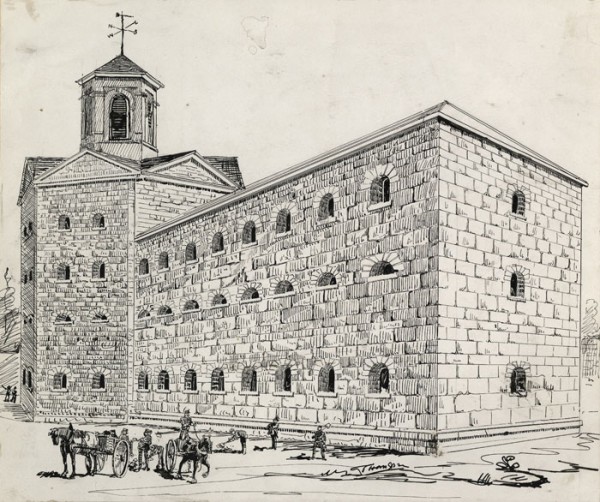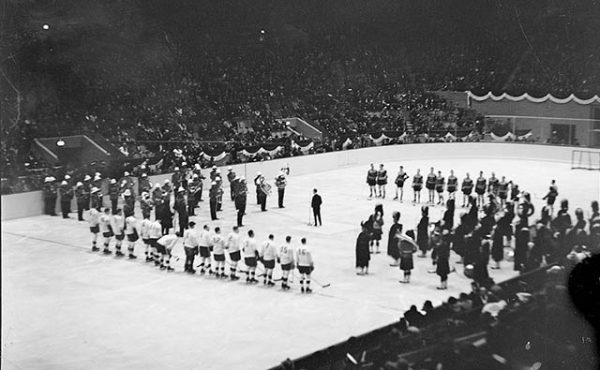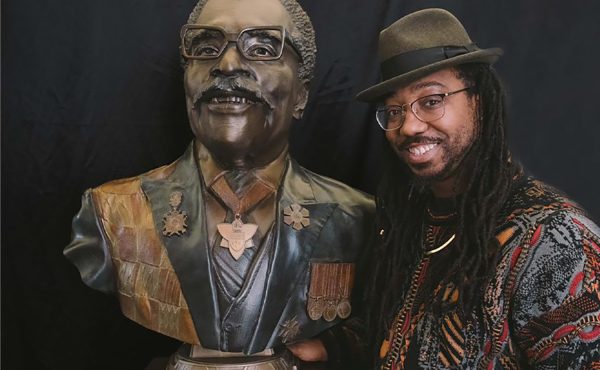“The morning broke dark and gloomy, and with the first faint streaks of early dawn the workmen were industriously employed in making ready the scaffold … the ghastly though business like machine.”
Outside the Home District Jail on Front St. between Berkeley and Parliament 156 years ago today, workers were assembling the gallows for James Fleming and James O’Leary, a pair convicted of separate murders but sentenced to hang together.
Despite the inclement weather, a large crowd gathered outside the walls of the jail that morning, eager to witness the rare double execution.
***
Thomas Madigan was found stabbed to death on 6th Dec. 1858 near the Commercial Saloon on Wellington St. That evening, 17-year-old James Fleming, an Irish-born former Grand Trunk Railway employee, had been drinking with “some women of loose character” at the bar, when an argument broke out over money.
Fleming brandished a knife and demanded one of the women repay him 50 cents he had given her earlier that night, but she had already spent it.
Later, a short walk from the bar, Madigan and a group of men from the Commercial Saloon who had seen the altercation encountered Fleming and another dispute began. Witnesses saw Fleming produce the knife again and hold it above his head.
The coroner ruled Madigan died from a single stab wound to the chest delivered with enough force to pierce the lung and left ventricle of the heart.
John McKay, the owner of the Young Canada Saloon where Fleming lived, testified that he had confiscated the knife and placed it in a locked drawer some months earlier, believing it to be dangerous. He said the accused had “a great hand for arguing” when he was drunk, but he had later returned the blade when Fleming said he planned to sell it.
On Jan 21, 1859, a jury found Fleming guilty of murder.
***
O’Leary, a 34-year-old itinerant lumber worker originally from Limerick, Ireland, was working for a contractor supplying material for a bridge over the Black River in Georgina, Ontario. According to the Globe, a dispute arose when O’Leary was payed $22 instead of the $40 he believed he was owed.
In court, Hugh Kelly, a fellow employee, testified that O’Leary had indeed been paid in full and the case was dismissed. After a brief period of apparent reconciliation following the incident, O’Leary and Kelly were walking home towards Georgina together after work:
“In the long bleak road, about a mile from the village, the tragic event took place for which O’Leary is about to expiate on the scaffold. The numerous and deadly stabs inflicted on his victim, the flight of the murderer, and subsequent arrest in the ‘bush’ with portions of the blood-stained garments on his person are facts which need no repetition,” the Globe wrote.
O’Leary admitted killing Kelly with a pocket knife, but only in self defence.
The jury didn’t agree.
***
The public gallows were built against the west wall of the jail on Front St. the morning of the executions. A heavy rain fell during the night and the area around the 14-foot wooden structure was a quagmire. Around 7:oo, O’Leary’s sister visited her brother’s cell one last time.
“They threw themselves into each other’s arms,” wrote the Globe. “His sister’s distress deeply moved the heart of O’Leary. He cried bitterly, and deplored his unhappy fate.”
O’Leary and Fleming were bound and shackled and the hanging ropes attached to the gallows around 8:00. The crowd outside the jail had swelled considerably and there were cheers when Sheriff Frederick William Jarvis appeared to make his final inspection.
Many pushed and shoved to gain the best view. Wagons were drawn up and used as makeshift podiums, as were several stone piles near the wall of the jail. The crush was enough to knock several people from their perches, resulting in cheers and bursts of laughter. Merchants, labourers, elderly women, mothers with babies, and children were all present, “pushing, crowding, and hooting.”
The condemned pair were led to the gallows at around 9:45, accompanied by Mr. William Davey, a Wesleyan City Missionary who ministered to the pair during their final night in prison, two reverends, and several police officers. The hangman, his face shielded by a dark mask, was a felon recently admitted to the jail for disorderly conduct. For executing O’Leary and Fleming he would be paid $80.
“From my inmost heart I do feel contrition for all my sins, and particularly for the crime for which I am now about to offer my life, and for which I would resign a thousand lives if I had them,” O’Leary told the crowd from the gallows. “May the Lord in Heaven have mercy on his soul,” called someone.
Fleming said nothing, choosing instead to remain in prayer as the cap was pulled over his head. When the clock of St. Lawrence Hall struck 10:00, Sheriff Jarvis gave the signal and the trap door beneath their feet was released.
“The bodies fell with a dull, heavy sound, which sent a shudder through all who heard it—there were a few struggles—and all was over: the wretched men had paid the fearful penalty of their crimes.”
***
O’Leary and Fleming were left suspended for half an hour while the crowd slowly dispersed. As was customary at the time, the bodies were cut down and post mortesm carried out that included weighing each of the brains. O’Leary’s remains were turned over to his family, but no-one claimed Fleming’s body.
It was taken in a coffin to the Necropolis cemetery by one of the reverends who had witnesses the execution “so that it might receive a decent burial.”





One comment
“…there were a few struggles—and all was over”
In other words they died by asphyxiation and not a broken neck.
I guess that’s what you get when you pay another inmate to be the hangman.